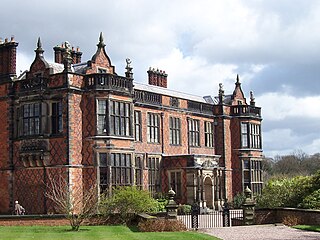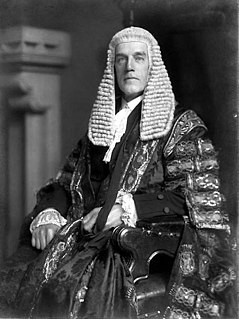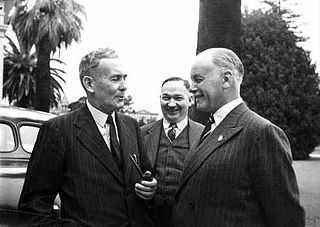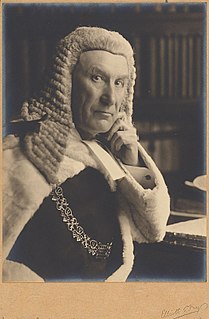
Earl of Warwick is one of the most prestigious titles in the peerages of the United Kingdom. The title has been created four times in English history, and the name refers to Warwick Castle and the town of Warwick.

Earl of Leicester is a title that has been created seven times. The first title was granted during the 12th century in the Peerage of England. The current title is in the Peerage of the United Kingdom and was created in 1837.

Baron Dudley is a title in the Peerage of England. It was created circa 1440 for John Sutton, a soldier who served as Lord Lieutenant of Ireland. The title descended in the Sutton family until the 17th century when Frances Sutton, the heir apparent to the title, married Humble Ward, who, himself, was granted the title Baron Ward in 1644. Their heirs inherited both titles until 1740 when the differing rules of inheritance meant that the Barony of Dudley descended on Ferdinando Dudley Lea, who became the 11th Baron whilst the Barony of Ward went to John Ward, who later became 1st Viscount Dudley and Ward. On Ferdinando's death in 1757, the title fell into abeyance. The title was revived in 1916.

Viscount Ashbrook is a title in the Peerage of Ireland. It was created in 1751 for Captain Henry Flower, 2nd Baron Castle Durrow. The title of Baron Castle Durrow, in the County of Kilkenny, had been created in the Peerage of Ireland in 1733 for his father William Flower. He was a Colonel in the Army and also represented County Kilkenny and Portarlington in the Irish House of Commons. He was praised by Jonathan Swift as "a gentleman of very great sense and wit". As of 2014, the titles are held by the first Viscount's descendant, the eleventh Viscount, who succeeded his father in 1995.

Viscount Hanworth, of Hanworth in the County of Middlesex, is a title in the Peerage of the United Kingdom.
Viscount Hampden is a title that has been created twice, once in the Peerage of Great Britain and once in the Peerage of the United Kingdom. The first creation came in the Peerage of Great Britain when the diplomat and politician Robert Hampden, 4th Baron Trevor, was created Viscount Hampden, of Great and Little Hampden in the County of Bedford on 14 June 1776. The title of Baron Trevor, of Bromham, had been created in the Peerage of Great Britain in 1712 for his father, the lawyer Sir Thomas Trevor. Both titles became extinct in 1824 on the death of the first Viscount's second son, the third Viscount.

Baron Auckland is a title in both the Peerage of Ireland and the Peerage of Great Britain. The first creation came in 1789 when the prominent politician and financial expert William Eden was made Baron Auckland in the Peerage of Ireland. In 1793, he was created Baron Auckland, of West Auckland in the County of Durham, in the Peerage of Great Britain. Eden notably served as Chief Secretary for Ireland, Ambassador to Spain, and President of the Board of Trade. His second son, the second Baron, was also a politician and served as Governor-General of India. In 1839 he was created Baron Eden, of Norwood in the County of Surrey, and Earl of Auckland, in the Peerage of the United Kingdom. However, he never married, and the barony of Eden and the earldom became extinct on his death while he was succeeded in the baronies of Auckland by his younger brother, the third Baron. He was Bishop of both Sodor and Man and Bath and Wells. The titles descended from father to son until the death of the sixth Baron in 1941. He was succeeded by his cousin, the seventh Baron. He was the son of the Hon. George Eden, third son of the fourth Baron. He was succeeded by his younger brother, the eighth Baron. As of 2013, the titles are held by the latter's grandson, the tenth Baron, who succeeded his father in 1997.

Baron Hotham, of South Dalton in the County of York, is a title in the Peerage of Ireland. It was created in 1797 for the naval commander Admiral William Hotham, with remainder to the heirs male of his father. Hotham was the third son of Sir Beaumont Hotham, 7th Baronet, of Scorborough, and in 1811 he also succeeded his nephew as eleventh Baronet. Lord Hotham never married and on his death in 1813 he was succeeded in both titles by his younger brother Beaumont, the second Baron and twelfth Baronet. He had previously represented Wigan in the House of Commons.
Baron Hives, of Duffield in the County of Derby, is a title in the Peerage of the United Kingdom. It was created 7 July 1950 for the Ernest Hives, Chairman of Rolls-Royce Ltd. As of 2010 the title is held by his grandson, the third Baron, who succeeded his uncle in 1997.
Baron Gainford, of Headlam in the County Palatine of Durham, is a title in the Peerage of the United Kingdom. It was created on 3 January 1917 for the Liberal politician Jack Pease, a member of the Darlington Pease family. He notably served as President of the Board of Education from 1911 to 1915. Pease was the second son of Sir Joseph Pease, 1st Baronet, and the grandson of Joseph Pease, while Arthur Pease was his uncle and Sir Arthur Pease, 1st Baronet, Beaumont Pease, 1st Baron Wardington, and Herbert Pease, 1st Baron Daryngton, were his first cousins. The third baron was a former member of the London County Council and of the Greater London Council. As of 2013 the title is held by his younger brother, the fourth baron, an architect and town planner; County Planning Officer for Ross and Cromarty 1967–1975 and Scottish Office Inquiry Reporter 1978–1993.
Baron Joicey, of Chester-le-Street in the County of Durham, is a title in the Peerage of the United Kingdom. It was created in 1906 for the coal mining magnate and former Liberal Member of Parliament for Chester-le-Street, Sir James Joicey, 1st Baronet. He had already been created a baronet, of Longhirst and of Ulgham, both in the County of Northumberland, in the Baronetage of the United Kingdom in 1893. He was succeeded by his eldest son, the second Baron. He was High Sheriff of County Durham in 1910. The second baron lost his son young, and on his death his younger brother succeeded to the barony. The third Baron was an army officer, whose elder son died in WWII without male issue, and he was thus succeeded by his younger son, the fourth baron. As of 2010 the titles are held by the latter's eldest son, the fifth Baron, who succeeded in 1993.
Baron Wigram, of Clewer in the County of Berkshire, is a title in the Peerage of the United Kingdom. It was created in 1935 for the soldier and court official Sir Clive Wigram, Private Secretary to King George V from 1931 to 1936. He was the grandson of Reverend William Pitt Wigram, ninth and youngest son of Sir Robert Wigram, 1st Baronet, of Walthamstow. As of 2019 the title is held by his grandson, a former equerry to Prince Philip, Duke of Edinburgh, who succeeded in May 2017.

Baron Norrie, of Wellington in New Zealand and of Hawkesbury Upton in the County of Gloucester, is a title in the Peerage of the United Kingdom. It was created on 22 August 1957 for Sir Willoughby Norrie upon his retirement as Governor-General of New Zealand. As of 2010 the title is held by his eldest son, the second Baron, who succeeded in 1977.

Baron Trevethin, of Blaengawney in the County of Monmouth, is a title in the Peerage of the United Kingdom. It was created in 1921 for the prominent judge Sir Alfred Lawrence, Lord Chief Justice of England from 1921 to 1922.
Baron Aldenham, of Aldenham in the County of Hertford, is a title in the Peerage of the United Kingdom that was created on 31 January 1896 for the businessman Hucks Gibbs. He was head of the family firm of Antony Gibbs & Sons and a director and Governor of the Bank of England. Gibbs also briefly sat as a Conservative Member of Parliament for the City of London. His fourth son Herbert Cokayne Gibbs was created Baron Hunsdon of Hunsdon in 1923. Lord Aldenham was succeeded by his eldest son, the second Baron. He also represented the City of London in the House of Commons as a Conservative. He was succeeded by his son, the third Baron. On the latter's death in 1939 the barony of Aldenham was inherited by his cousin the second Baron Hunsdon of Hunsdon. He served as chairman of Antony Gibbs & Sons. As of 2017 the titles are held by his grandson, the sixth Baron, who succeeded his father in 1986.

Earl of Worcester is a title that has been created five times in the Peerage of England.
Baron Daryngton, of Witley in the County of Surrey, was a title in the Peerage of the United Kingdom. It was created on 12 February 1923 for Herbert Pike Pease, who had previously represented Darlington in Parliament as a Liberal Unionist. He was the younger son of Arthur Pease and the younger brother of Sir Arthur Pease, 1st Baronet, while Sir Joseph Pease, 1st Baronet, was his uncle and Jack Pease, 1st Baron Gainford, his first cousin. The peerage became extinct on the death of his son, the 2nd Baron, in 1994.
John William Beaumont Pease, 1st Baron Wardington, was a British banker.
The Pease family is an English and mostly Quaker family associated with Darlington, County Durham, and North Yorkshire, descended from Edward Pease of Darlington (1711–1785).

There have been two baronetcies created for members of the Pease family, both in the Baronetage of the United Kingdom. Both titles are extant.









